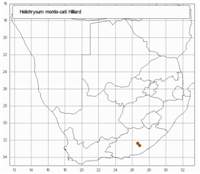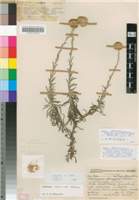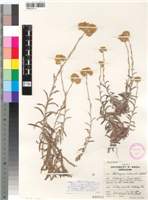Origin of name:
montis = mountainscati = refers to the Cata Forest Reserve where it grows
Diagnostic characters:
Long linear soft bi-coloured leavesVery dense round cluster of heads
Description:
Bushy half shrub, sprawling or erect to c. 1-3 m, branches long and slender, greyish-white woolly-felted, closely leafy, leaves more distant on flowering twigs, all but the reduced leaves spreading, reflexed with age. Leaves 18-60 x 2-6 mm, reduced leaves below flowering heads c. 8-15 x 1-2 mm, linear, acute, mucronate, passing into lanceolate, acuminate, scale-tipped bracts, base broad, half-clasping, margins more or less revolute, upper surface cobwebby at first, glabrescent, rugose, gland-dotted, lower surface greyish-white woolly-felted; dry leaves persistent for at least two seasons. Heads heterogamous, campanulate, c. 4 x 3 mm, many in congested glomerules 15-25 mm across at the branch tips. Involucral bracts in c. 5 series, imbricate, outer shorter, inner subequal, equaling flowers, tips subacute or obtuse, somewhat erose and crisped, recurved but scarcely radiating, translucent, pale golden-brown. Receptacle shortly honeycombed. Flowers 21-31, 2-7 female, 18-27 homogamous, bright yellow. Achenes 1 mm long, with myxogenic duplex hairs. Pappus bristles many, equaling corolla, scabrid, bases cohering strongly by patent cilia.
Flowering in October and November.
Distribution:
Grows in rough herbage near forest. Known only from Katberg Pass, and Cata Forest Reserve and Hogsback in the nearby Amatola mountains of the E. Cape.
Grassland and Thicket Biomes.
Taxonomy:
Literature:
Helichrysum montis-cati Hilliard in Notes R. bot. Gdn Edinb. 40: 262 (1982).
Type:
Eastern Cape, Stockenstrom div., Katberg Pass (3226 BC), c. 5000 ft. 28 x 1980, Hilliard & Burtt 13261 (NU, holo.; E; K; MO; PRE; S, iso.).
Synonym(s):
Vouchers:
Esterhuysen 13252 (BOL); Hutchinson 1672 (BM; BOL; K: PRE mixed with H. odoratissimum); Sidey 3747 (K; PRE; S); Story 3189 (GRA; PRE).



